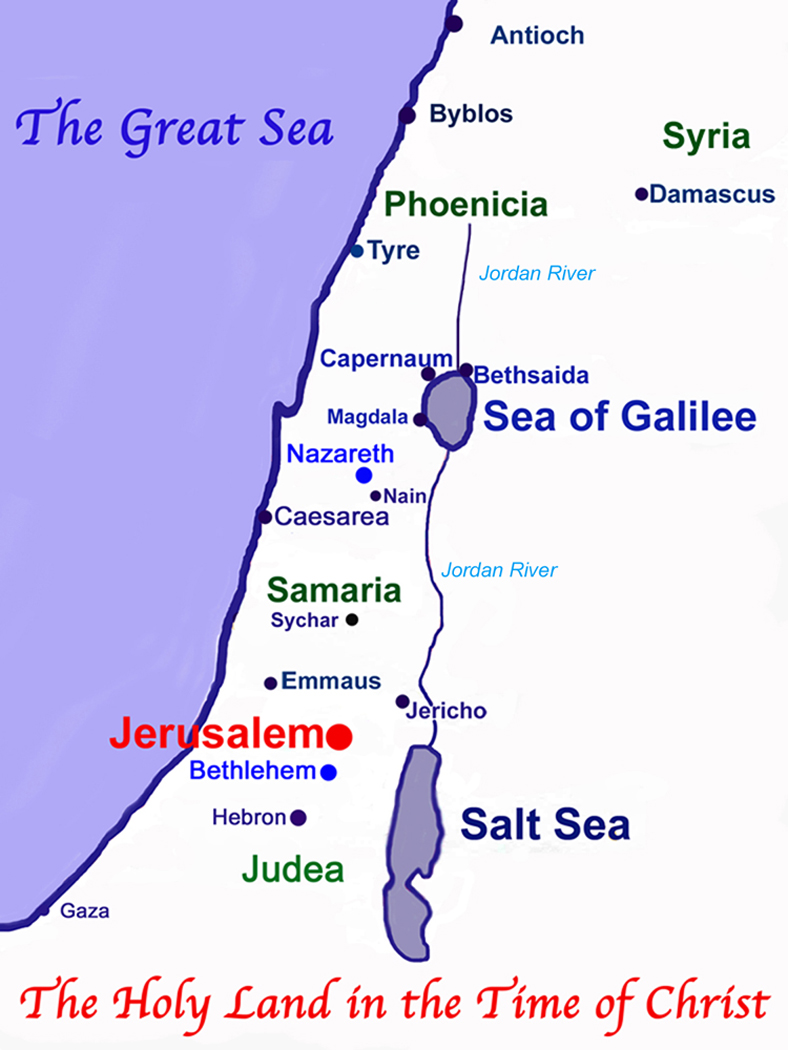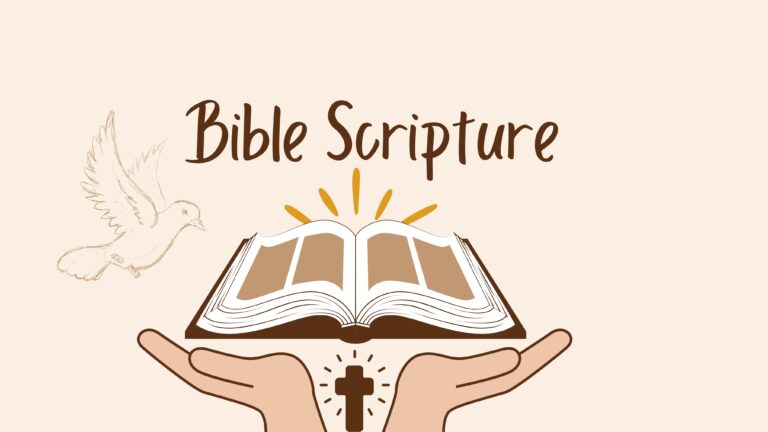“In the beginning, God created the heavens and the earth.” — Genesis 1:1

The Bible is not just a book. It’s the inspired Word of God, a testament to His unending love for us, His creation. It unfolds the story of salvation: how God revealed Himself and His plan for redeeming a world that had fallen from grace.
This sacred text begins with the creation of the world, passes to the definitive moment in time of the Incarnation, and is concluded with the Parousia, the Second Coming of the Lord.
The promises and prophecies of the Old Testament find their fulfillment in the New Testament through the life, death, and resurrection of Jesus Christ, God’s only Son, sent to rescue humanity.
This page is dedicated to explaining the Bible’s intricate structure, its historical and spiritual significance, and the wealth of wisdom contained within its chapters. We aim to make the complexities of the Bible understandable and relevant to modern readers, whether they are lifelong believers or new seekers of spiritual depth.
Structure and Content of the Bible
The word Bible, which means “the book,” is derived from the city of Byblos, a key source of the Phoenician alphabet. Its structure is divided into two main parts: the Old Testament and the New Testament.
The Old Testament, which was written in Hebrew, tells the story of God’s relationship with the world before Jesus Christ came. It includes the creation of the world, the story of Abraham and his family, and the history and laws of the Israelite people. It also has teachings and predictions about a Messiah who would come to save everyone.
This part sets the scene for the New Testament, written in Greek, where these promises start to come true with the life of Jesus Christ and the impact of his teachings on the early Christian community.

The Old Testament
The Old Testament, or Hebrew Scripture, is not just a historical record but a revelation of God’s undying love for His creation. It narrates God’s creation of the world, His words to Israel, and His promise of a Redeemer to save humanity from sin and disobedience.
Throughout the Old Testament, numerous prophecies foretell the coming of a Messiah. These include:
- Genesis 3:15
- Deuteronomy 18:15-18
- 2 Samuel 7:14-16
- I Chronicles 17:12-14
- Psalms 2, 22, and 110
- Isaiah 7:14 and 52:13-53:12
- Daniel 7:13-14 and 9:24-27
- Micah 5:2
- Zechariah 9:9 and 12:10
These prophecies bridge the Testament’s narrative from creation’s dawn to a future of redemption and salvation.
The Old Testament is traditionally divided into three main sections: the Law (Torah or Pentateuch), the Prophets (Nevi’im), and the Writings (Kethuvim or Hagiographa).
The threefold division and original order of Hebrew Scripture was evident at the time of Jesus, who referred to “The Law of Moses and the Prophets and the Psalms (Luke 24:44).”
The writings of the Old Testament are preserved in three languages – Hebrew, Aramaic, and Greek. They are available in the following manuscripts:
- The Greek Septuagint from Alexandria;
- The Masoretic Hebrew text from Tiberias, Galilee;
- The newly discovered Dead Sea Scrolls of the Essenes;
- The Aramaic Targums and the Syriac Aramaic Peshitta Bible.
The differing traditions have led to the disparity found in the Old Testament canons among Christian religions.
The major part of the Old Testament was composed in Hebrew, except for the following parts, written in Aramaic:
- Genesis 31:47
- Jeremiah 10:11
- Ezra 4:8-6:18 and 7:12-26
- Nearly half of the Book of Daniel (2:4-7:28)
The Greek parts of the Old Testament primarily refer to texts found within the Greek Septuagint, a translation made in the third century BC in Egypt by Jewish scholars who had migrated there during the Diaspora.
The Greek codices arranged the books in a fourfold division, a different way than Hebrew Scripture, by placing the Law of Moses first, then the Historical Books (Former Prophets), then the Psalms and Wisdom Literature, and then the (Latter) Prophets.
The three major Christian religions follow the Greek pattern and will serve as the outline for this discussion.
The Law
The Law, also known as the Torah or Pentateuch, is the first section of the Old Testament and contains the five Books of Moses.
- Genesis describes God’s creation of the world and our first parents Adam and Eve, the Flood, and God’s Covenants with Noah and the Patriarchs of Israel, Abraham, Isaac, Jacob, and Joseph. Genesis 3:15 is the first announcement of the Redeemer. The historical pattern of covenant, fall, judgment, and redemption that begins in Genesis remains consistent throughout the Old Testament.
- Exodus records the history of Moses, the Ten Commandments of God, the Ark of the Covenant, the Exodus from Egypt, and the Passover feast, which serves as a Memorial of the Exodus event.
- Leviticus relates the laws pertaining to religious observance, such as the Festivals of the Lord, and proper conduct, such as to abstain from homosexuality (18:22), to help the poor (19:10), to love your neighbor (19:18), and to refrain from tattoos (19:28) or consult fortune tellers (19:31).
- Numbers is so named because of two censuses taken of the Israelites, and their wandering in the Sinai Desert for forty years because of their disobedience to the Lord God.
- Deuteronomy repeats the Ten Commandments and religious laws, and predicts the consequences of Israelite behavior in the Promised Land.
Together, these books emphasize the themes of faith, obedience, and redemption that resonate throughout the Old Testament.
The Historical Books
The Historical Books of the Old Testament provide a narrative of the Israelites from their entry into the Promised Land to the post-exilic period.
These books include Joshua, Judges, Ruth, Samuel, Kings, and Chronicles, as well as the Books of the Restoration – Ezra, Nehemiah, and Esther.
- Joshua records the entry of the Israelites into the Promised Land and the conquest of Canaan. Judges describes the time when the Lord raised Judges, such as Samson, to save his people, a time when there was no king in Israel.
- Ruth is one of the five Megillots or scrolls and traces the ancestry of the Davidic dynasty and ultimately that of the Messiah.
- The Books of Samuel and Kings were made into two books each.
In First Samuel, the prophet Samuel anointed Saul, who failed as the first monarch because of his disobedience. The young shepherd David was faithful to the Lord and defeated Goliath.
In Second Samuel, David united all twelve tribes and became King of all Israel. He brought the Ark of the Covenant to Jerusalem, which became the capital of the United Kingdom of Israel.
- Kings continue the narrative, detailing the reign of Solomon.
First Kings begins with David’s son, King Solomon, who built the first Jerusalem Temple of the Lord, which housed the Ark of the Covenant. Disobedience to the Mosaic Law led to the Divided Kingdom of Israel and Judah.
Second Kings records the preponderance of Kings who broke covenant with the Lord, and the subsequent capture of the Northern Kingdom by the Assyrians in 722 BC, and the destruction of the Jerusalem Temple with the Babylonian Captivity in 586 BC.
2. The two books of Chronicles offer a sweeping view of history from Adam to the United Kingdom of Israel until the announcement of King Cyrus to allow the people of the Babylonian Exile to return to Jerusalem and Judah.
3. Books of the Restoration include stories of Ezra, Nehemiah, and Esther. The Second Temple in Jerusalem was rebuilt and completed in 516 BC during this period, known as the Restoration.
Ezra restored the Mosaic Law, while Nehemiah restored the twelve gates and walls of Jerusalem.
The Book of Esther described the Jewish heroine Esther and the Jewish Diaspora that stayed behind in Persia and did not return to Jerusalem during the Restoration.
The Book is the source of Purim or the Festival of Lots.
Wisdom Literature
The Wisdom Literature of Hebrew Scripture consists of Psalms, Proverbs, Job, Ecclesiastes, and the Song of Songs.
It offers profound insights into human existence, divine wisdom, and the pursuit of a righteous life, blending poetry, philosophy, and theological reflection.
The Prophets
The Prophets cried out over the moral breakdown during the Divided Kingdom of Israel and included:
- The Major Prophets – Isaiah, the Books of Jeremiah and Lamentations, Ezekiel, and Daniel.
- The Prophets of the Book of the Twelve – Hosea, Joel, Amos, Obadiah, Jonah, Micah, Nahum, Habakkuk, Zephaniah, Haggai, Zechariah, and Malachi.
Deuterocanonical Books
Commissioned by Pope Damasus in 382, the linguist St. Jerome (345-420) in Bethlehem produced a new translation of the Bible into Latin, the New Testament Gospels by 384 and the Old Testament by 405.
St. Jerome translated from both Greek and Hebrew manuscripts of the Old Testament and noted the difference between the larger canon of the Greek Septuagint and the shorter Hebrew canon, and called those books comprising the difference the “hidden or secret books” or the Apocrypha.
The books of the Apocrypha were written during post-exilic Second-Temple Judaism, after the time of Ezra and the Restoration but before the time of Jesus and the Roman destruction of the Temple in 70 AD.
To support the traditional use of the Greek Septuagint as the source of the Christian Old Testament, St. Augustine and the Council of Hippo in 393 AD preserved seven books of the Apocrypha in the Old Testament Canon, known as the deuterocanonical books:
- The Books of Tobias (Tobit)
- Sirach
- First and Second Maccabees
- Wisdom
- Judith
- Baruch
- The Greek parts of Esther (the name of God and Daniel which includes the Prayer of the Three Young Men, the saga of Susanna, and Bel and the Dragon).
St. Jerome included these for a total of 46 Books in his Latin Old Testament.
The Latin Vulgate Bible served as the standard Bible for Western civilization for over 1000 years.
Canonical Variations
The Hebrew canon for Judaism developed through the ages, and recognized 10 books less than the Greek Septuagint.
The Masoretic Text of Tiberias, Galilee, developed from the eighth through tenth centuries AD, reflected the traditional canon of Hebrew Scripture. The discovery of the Dead Sea Scrolls has shed new light on early Hebrew writings.
In summary, modern Christianity reflects the lack of uniformity found in the canon of the Old Testament, for Catholics and Eastern Orthodox, continue to refer to the Greek Septuagint as the Old Testament while Protestants choose the Masoretic Hebrew text.

The New Testament
The New Testament recorded the oral tradition of the Life and Teachings of Jesus Christ, his Passion, Death on the Cross, Resurrection, and Ascension, and the formation of the early Christian community, the Church.
It captures the essence of Christ’s message and the beginnings of Christianity, offering guidance and hope to believers.
The Language of Jesus
Jesus of Nazareth and his Apostles spoke Aramaic, the common language at the time in the Levant. Syriac, a dialect of Aramaic, became the biblical and liturgical language of early Christian Churches in the East.
Jesus the Messiah addressed God in prayer, using the Aramaic word Abba, the affectionate term for “Father” (Mark 14:36). Jesus raised the child by calling out Talitha cumi, which means “little girl, arise” in Mark 5:41.
He cured the man who was deaf and dumb by speaking Ephphatha, meaning “be opened” in Mark 7:34. Jesus refers to hell as Gehenna in Mark 9:42-50.
Jesus used Aramaic words twice in referring to Peter: he used the prefix Bar-, “the son of,” (not the Hebrew Ben) when he called Peter Bar-Jonah, the son of Jonah (Matthew 16:17); and he called Peter Cephas, the Aramaic word for rock in John 1:42.
He cried out from the cross Eloi, Eloi, lama sabachthani, that is, “My God, my God, why have you forsaken me?” (Matthew 27:46, Mark 15:34).
No original manuscript by the author of a biblical book has ever been discovered!
The oldest manuscripts available to us are the Curetonian and Sinaiticus texts of the Old Syriac Gospels, the Greek Codex Sinaiticus from St. Catherine’s Monastery on Mt. Sinai, Egypt, and the Codex Vaticanus in Greek from the fourth century AD.
Scriptural Foundation and Typology
New Testament writings were considered Scripture in the early Christian Church, as evidenced by references in I Timothy 5:18 and II Peter 3:16.
This acknowledgment underlines the profound respect and continuity between the Testaments, showcasing the New Testament’s fulfillment of the Old.
The writers of the New Testament deeply valued the Old Testament as Divine Revelation. They proclaimed this revelation found its fulfillment in life and teaching, and above all in the death and resurrection of Christ Jesus, the source of forgiveness and everlasting life.
They frequently drew upon the Old Testament writings, primarily to confirm Jesus Christ as the Messiah, or to serve as a source for moral instruction, or for the interpretation of events.
Typology, a significant aspect of biblical studies, interprets Old Testament passages as prefigurations of New Testament events.
For example, referring to Christ, Paul called Adam “a type of the one who is to come” (Romans 5:14). Moreover, Peter saw the flood during the times of Noah as a figure of baptism (I Peter 3:20-21).
Direct quotations from the Old Testament further cement this relationship. Matthew 1:22, referencing Isaiah 7:14, confirms the prophecy of the Messiah’s virgin birth. Jesus Himself drew upon Genesis during His teachings on marriage (Mark 10:2ff), emphasizing the continuity of divine instruction.
Allusions and indirect references also play a crucial role. Paul’s mention of Genesis 3:15 in Romans 16:20 and John’s allusion to the “ancient serpent” in Revelation 12:12 are examples where the New Testament integrates Old Testament themes without explicit acknowledgment.
And finally, the source may be unknown, as in Matthew 2:23, when he cites the prophecy, “He shall be called a Nazarene.”
Fathers of the Church
The Tradition of the Church Fathers was important to the Church, for they had an important role in the formation of the canon of the New Testament – to choose those inspired books that best reflected the life and teachings of Christ, as well as the interpretation of Scripture.
Irenaeus of Lyons circa 180 AD was among the first to propose a canon for the New Testament.
Three Fathers of the Church – Athanasius of Alexandria in his Letter of 367, Jerome at Bethlehem in 384, and Augustine at the Council of Hippo in 393 – agreed that 27 Books were the inspired Word of God.
The Canon of the New Testament was confirmed at the Third Council of Carthage in 397 AD.
The Four Gospels
“It is written, ‘Man shall not live by bread alone, but by every word that proceeds from the mouth of God.” — Gospel of Matthew 4:4
At the heart of the New Testament are the four Gospels of Matthew, Mark, Luke, and John.
Each Gospel provides a unique perspective on Jesus’s life, ministry, death, and resurrection, offering a multifaceted portrait of the Savior.
The Four Gospels of Matthew, Mark, Luke, and John proclaim the “Good News” of the coming of Jesus Christ. Matthew, Mark, and Luke called the Synoptic Gospels as they parallel each other, and record Jesus’ teaching in Parables.
Each of the Synoptics is noteworthy on its own, such as the Gospel of Matthew, which contains the Sermon on the Mount with the Beatitudes, the Lord’s Prayer, and the Golden Rule.
Matthew and Luke are noted for their Infancy Narratives, describing the Nativity of Our Lord.
The Synoptic Gospels also record the Last Supper of Christ and his direction to “Do this in remembrance of me” (Luke 22:19), the foundation for the Liturgy of the Eucharist, the Memorial of the Last Supper.
The Gospel of John is a unique spiritual and theological work, beginning with the Prologue – a mystical reflection on the Word, the Divinity, and the Incarnation of Jesus Christ.
The Gospels present the Miracles and the Paschal Mystery of Christ Jesus – his Passion, Death on the Cross, Resurrection, and Glorious Ascension into Heaven.
“For God so loved the world that he gave his only Son, that whoever believes in him should not perish, but have eternal life.” — Gospel of John 3:16
There are 3 stages in the development of the Gospel narrative:
- The teachings of Jesus himself.
- The oral tradition of the Apostles, who handed down the teachings of Jesus to the early Christian community, the Church.
- The inspired written Word of Scripture.
The Bible was written within the Church. Considering the impact of his life and teaching, it is remarkable that the Ministry of Jesus lasted such a short time!
The Acts of the Apostles
The Acts of the Apostles is the second book written by Luke and describes the dramatic emergence of Christianity following Pentecost, the Descent of the Holy Spirit.
Acts records the growth of the early Christian community, the Church, from Jerusalem, Judea and Samaria, Syria to Asia Minor, Europe to Rome, focusing primarily on the activities of Peter, and Paul following his Conversion.
Pauline Letters
The Pauline Epistles form a crucial part of the New Testament. These letters offer theological insights, moral guidance, and the practical aspects of Christian life.
- The Pauline corpus begins in the New Testament with the Letter to the Romans, which emphasizes God’s righteousness that saves all who believe in Jesus Christ. The letter begins and ends with the ideal Christian response to our merciful Savior, “the obedience of faith” (Romans 1:5, 16:26).
- First Corinthians gives us an insight into the early Christian community, includes a beautiful passage on love, and speaks of the Resurrection of Christ and of the dead, as well as the Resurrection Event.
- Second Corinthians is personal in nature and reveals much about Paul’s character. We are reminded that God’s grace is sufficient for us
- The Apostle to the Gentiles emphasizes the way to salvation is through Christ and the Cross in Galatians.
- The Epistle of St. Paul to the Ephesians is the Pauline letter to the Church.
- The Philippians were Paul’s first Christian community in Europe, and the letter shows his great love for the Gospel and his converts.
- Colossians calls Jesus the head of his body, the Church.
- First Thessalonians was the first writing to become part of the New Testament, which speaks of the Parousia, the second coming of the Lord.
- Second Thessalonians relates the events before Parousia and emphasizes the importance of the work ethic.
- The Pastoral Epistles (1 Timothy, 2 Timothy, and Titus) focus on church leadership and Christian living.
- The Letter to Philemon touches on Christian brotherhood and the question of slavery.
- The Letter to the Hebrews is an outstanding treatise on the priesthood of Jesus, who redeemed mankind by his one Sacrifice, which established God’s New Covenant.
Of the 14 letters of the Pauline Corpus, all but the Letter to the Hebrews begin with the name of Paul. St. Jerome added Hebrews to the Pauline Corpus when he translated the Greek New Testament into Latin in the fourth century AD.
The Universal Epistles
The seven catholic or universal Letters of James (1), Peter (2), John (3), and Jude (1) are so called because they are addressed to all the Churches, unlike the letters of Paul, which are addressed to a particular community (example: Romans).
They were open letters that concerned themselves with different themes pertinent to Christians.
- The Letter of James emphasizes the necessity of faith and works and speaks of the power of the tongue.
- First Peter shows us the mission of the early Church in the midst of a hostile society, and provides direction for Christian behavior in the world.
- Second Peter notes that God bestows on us life and godliness, that living a virtuous life will ensure our calling and election to eternal life with Christ.
- First John expresses that God is love, his forgiveness in the face of sin, and asserts the humanity and Divinity of Jesus Christ.
- Second John warns against heresy in the early Church.
- Third John is a testimony to the fidelity of early Christian communities.
- The Book of Jude gives encouragement for fidelity to the Christian faith and notes the moral implications of the Gospel message.
The mysterious Book of Jude also describes a phenomenon noted in some anesthetic patients with near-death experiences:
“They are like wild waves of the sea, foaming up their shameless deeds, wandering stars for whom the gloom of darkness has been reserved forever.”
The Book of Revelation
The Book of Revelation is the final Book of the New Testament and is apocalyptic in nature.
This book, rich in symbolism, may initially appear
- Frightening, as it speaks of the rise of the evil one, the Great Tribulation, and the end of the age;
- Dramatic as it describes the final battle of good and evil;
- And, above all, optimistic, as it points to the triumph of Jesus Christ over evil and the dawn of a New Creation.
Written by John, it has fascinated readers for centuries as it prophesies about the End Times, a time that may be drawing near.














